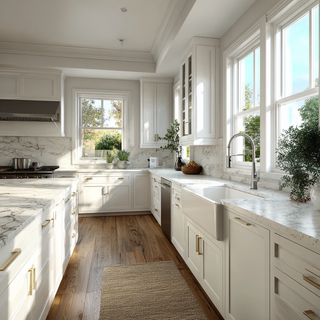Wood cabinets are one of the most defining features of any kitchen. They anchor the space visually, provide much-needed storage, and play a big role in setting the overall tone of your home design. Whether you’ve chosen crisp painted cabinets, richly stained wood, laminated finishes, or sleek PET surfaces, one universal truth remains: cabinets take a lot of daily abuse. From grease and fingerprints to cooking smell and dust, they fight year in and year out with the typical offenders that take their toll. Silver lining there is you can refinish your cabinets to like-new and keep them that way for decades if that is your heart's desire. Not all cabinets are created equal, though, nor is the same amount of effort to clean those particular cabinets.
Cabinet tops are treated gently, wood is pre-conditioned in mild treatment always to laminates so that they won't get scratched by their closing top, and PET finishes will need professional application otherwise they will very easily get scratched. Deconstruction continues even here in this article of cleaning your different types of cabinets, natural ways of making them shiny, and dos and don'ts which will make your investment.
Painted cabinets
1.Routine Cleaning
Painted cabinets bring color and fun to the kitchen but not a speck of maintenance. Effective daily work of effective daily maintenance in the guise of wringing with a wrung-out microfiber towel and one drop of soap. Microfiber will dust and dirt without scratching and soap will cut little dirt. Hard wringer your towel always—paint won't stand standing water.
For cleansing liquids, soft soap and water and soft sponge. Wet wash cloth with water to use and dry immediately. Soft cleaning given daily rather than oiliness otherwise in radical drastic healing.
2.Deep Cleaning
These oil-soaked cabinets were oiled years ago. Warm water and a few drops of white vinegar wipe up oil spills. This home remedy treatment will emulsify oil but not paint if done carefully. It is never used for the first time on an open surface since vinegar has acid, and that will stain some finishes.
Never scrub using scrubbing pads. Let stand for a minute or two on soil stain and wipe away with a gentle hand. Wash clean with water and slowly dry.
3.Restoring Shine and Maintaining Finish
Spotted finishes are not reflective woods but must be smooth and flat. Refinish with water-based furniture wax specifically designed to refinish paint finishes in an effort to provide an aged look. Do not refinish using oil-based finishes that will become yellow on paint during future decades.
Sealing: Use thin coat of clear cabinet wax every two years. It creates warm sheen and will not soak up fingerprints or moisture.
4.What to Avoid
Never, ever clean painted cabinetry with abrasives, bleach, or ammonia. Cleaners will haze and streak if they touch the finish, or worst of all, strip the finish completely. Scouring pads and steel wool are not even a choice—rub and destroy the finish.
Stained Wood Cabinets
1.Routine Cleaning
Wood-stained cabinetry exposes wood grain, so they don't possess that sticky feeling but nice one. Wipe with microfiber cloth or vacuum it quickly out on a daily routine. Squeeze out wet rag in warm soapy water to clean up every now and then.
Dry with towel too because there is water and it flows and stains and warps into seams.
2.Deep Cleaning
Wherever cooking and oil intersect, oil will adhere to dirty cabinets, especially the stovetop region. There, mix water and white vinegar and dish soap. Where sticky spots are, mix water and baking soda and make a paste, use sparingly in place with a rag, and wash out. Baking soda is a mild scrubber but fine on wood finishes in small amounts.
Never soak excessively stained wood too heavily. Water will bubble the stain or destroy the clear topcoat.
3.Restore Shine and Maintaining Finish
Conditioned cabinets are not necessary but they are worth the trouble on stained wood. Follow up with a conditioner or mineral oil specifically designed to do so to seal wood's shiny finish from drying out and cracking. Apply sparingly with a soft cloth and buff to natural shine.
For long-term protection, apply a paste wax to stained wood. It creates a thin water seal and will not close wood grain.
4.What to Avoid
Never, ever apply silicone polishes; they migrate into cracks and destroy future refinishing. Never, ever use abrasives like TSP, ammonia, or bleach—these remove stain and destroy the surface irreparably.
Laminated Cabinets
1.Routine Cleaning
Laminate cabinets just don't require that level of maintenance where they're not a plastic surface-anymore. Towel it with a microfiber towel with a little scratch of dish soap on it to the post-work evening crunch. Grease tends to hang around edges and corners, and laminates will coax most spills out.
2.Deep Cleaning
Hot water and half and half mixture of household cleaner or vinegar will strip greasy dirty surfaces. Clean, rinse, and dry. Laminate cabinets must never get wet since water works behind edges and swells.
3.Restoring Shine and Maintaining Finish
Laminate is oil-free wood and never needs conditioning. Microfiber dries with surface buff streakless when washed. Some polish laminate-safe sometimes just for extra shine but optional.
4.What to Avoid
Never use hard scrubbers because they scratch. Never use abrasive cleaners like paint thinner or acetone because they melt or warp the laminate finish.
PET Cabinets
1.Routine Cleaning
PET finishes are the crème de la crème with that gorgeous silky smooth appearance. Smooth finish will smear and fingerprint but show some, though. Soap and water and solution-thinned water with solution-thinned water wet microfiber cloth is all regular washing needs. Magic word here is microfiber again, too—it won't damage the finish if it can't brush it off.
2.Deep Cleaning
For grease or stain, warm water and vinegar. For heavy stains, PET-safe cleaning solution since it won't haze the finish. Microfiber dries air and won't streak.
3.Restoring Shine and Maintaining Finish
PET cabinets are gloss finished. Re-grade them every now and then to spray the gloss with a PET-safe spray cleaner. Microfiber clean with wipe in a circular motion dry. Don't condition oil-based since they will streak their shiny reflective finish and flatted.
4.What to Avoid
Chemical cleaners, steel wool, and scrubbing pads are similarly undesirable for PET cabinets. They are easily scratched and, having been scratched, cannot be polished.
Home-Made vs. Commercial Cleaners
The homeowner will probably be persuaded to make and use home-made, non-toxic cabinet cleaners or to buy store cleaners for cabinets. Both options have merits—and several drawbacks.
Among the things already in your home, such as mild dish soap, olive oil, water and vinegar solution, and baking soda, are non-toxic, inexpensive, and will not break your purse.
They will:
Remove grease all-purpose without being abrasive.
Vinegar, for example, will dissolve oils and leave absolutely nothing behind, and baking soda will dissolve sticky stuff down without hurting most surfaces. They're chemical-free chemical strippers that are homeowner- and kitchen-safe and make the kitchen smell clean and naturally so. Professional cleaners are strippers that erase individual problems with a wipe—water spots, food spots, or grime, say—without damaging surfaces. They're cleaning agents that the manufacturers themselves sell for painted, PET, or laminated surfaces where housewives must clean minute detail. They dry quicker, as well, so long-duration cleaning marathons aren't backbreaking. They're just more chemically active and perfumy, that's all. They'll do the job but dry out sensitive skin and destroy finishes when used without knowledge. They cost less to run day in and day out than your home-brews. Gentle is luxury: keep your home-mades for daily cleaning and save your bought ones for that occasional deep cleaning when grime is migrating out of reach. And then there's the best of both worlds—the easy natural day-to-day cleaning for general tidying and that extra oomph when you need one.
Conclusion
Having your wood cabinets as good as they can possibly get looking, smelling, feeling like it just rolled off the showroom brand new is really just learning what something needs.
Strained cupboards can be gently wiped with water-based cleaners at best as a last resort in an effort to keep their finish alive.
Grained wood has to be conditioned in an effort to cause its grain to stand out. Gentle cleaners and topcoat laminate dry so that they never become wet enough to puff up. PET cupboards will be safest scratched and cleaned with microfiber cloths. Regardless of what your cupboards, it's always the same: consistency. Every day's cleaning makes it an imputation for dust to settle on it, and every now and then cleaned makes them new. To own the material in your tool box—make your own or buy it—is to own money earning dividends in fifty years. Your kitchen cabinet will be much more than a utilitarian storeroom closet in utilitarian form. It will heat your house, be a stunning sight to the eye, and increase in worth.
We carry RTA cabinets in every material and color; our best-sellers are white cabinets, modern green cabinets, and brown cabinets.

























